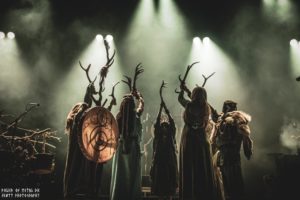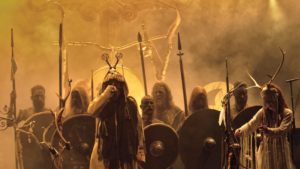Last night J. and I went to see Heilung (link takes you to their FB page) at the Roseland Theater in Portland, OR.
It was an enchanting and odd experience.
They call it ritual.
Never heard of Heilung? I’m not surprised. They are fairly new and until this year toured exclusively in Europe. But they are also almost exploding onto the music scene: their self-released first album, Ofnir, debuted in 2015, and they did their first live performance in 2017. So . . . you’ll be seeing more of them I predict.
One of the group’s founders, Kai Uwe Faust, is a tattoo artist specializing in Old Norse images. The other, Christopher Juul, is a producer, and the third is singer Maria Franz, formerly of the prog rock group Euzen. Growing up, each was drawn to their local “living history” Viking reenactments, which seems like a kind of local SCA movement in that participants create and wear authentic clothing and participate in period-specific pastimes. They call their work “amplified history.”
Heilung — which means healing in German — uses texts and images from a diverse group of Northern European cultures: German, English, Gothic, Old High German, Icelandic, Old English, Proto-Norse, Proto-Germanic, and Viking age Old Norse to create their performances. Their work has been described as experimental folk metal and pagan folk metal; to my ear it defies easy explanation.
They call it ritual.
In an interview with Revolver magazine, Faust says, “We try to give a little spark of that emotion: to make people feel how it is to be surrounded by nature, to slaughter their own cattle, to build their own drum, to live from the Earth,” Faust says. “Every attempt to connect it to modern stuff that makes us sad is not important.” Their Youtube channel says, “We used everything from running water, human bones, reconstructed swords and shields up to ancient frame drums and bronze rings in the songs…. Every attempt to link the music to modern political or religious points are pointless, since Heilung tries to connect the listener to the time before Christianity and its political offsprings raped and burned itself into the northern european mentality.”
- Let me give you a description of how it went before I offer any commentary:
The lights dimmed and the audience exploded in anticipatory wolf howls and cheers which faded. I could hear the sounds of bird calls and a stream which was quickly drowned out by the audience talking — not so much on the floor, where many people were waiting respectfully in silence — but up in the seats. (I think the people in the seats talked almost constantly through the entire event.) - Two women and a man came out (more cheers) and we watched as he smudged everything and every direction as the women paced and did — to my barely tutored eyes — a Native American dance. All of Heilung joined them and the man called a prayer that started “Remember that we are all people . . .”. The audience repeated every line he called, clearly conversant with this as an expectation.
- The three Natives left the stage (with no acknowledgment from the crowd) and a member of Heilung blew through an animal horn while others tapped sticks on dry animal jawbones or beat mallets against the stretched animal skin of drums and then the priest began chanting some throaty vocals of a song.
- Throughout the ritual there is a repeated motif of an inspection and consecration of four dirt-covered warriors carrying shields and spears. At one point, the priest uses rope to bind a spear to a topless woman, then tightens a thin noose around her neck to send her to the ground. The bound woman is revived by the priestess (Franz) who then pulls the spear from the ropes, freeing the woman.
- Later, the freed woman returns. She holds flaming antlers in each hand and raises them above her head while mesmerizing song swirls around her.
- The night ends with the Native American dancers returning for a group session of movement, some guy in druid gear smudges the stage again and it’s over.
Few of the words spoken, sung, or chanted thereafter were in English. But that’s rarely a problem in music as its power is to convey a message without words. And I truly found the near-constant pulse of drumming and dull, throaty roar of harmonized voices thrilling. Franz’s voice is exquisite and hypnotizing.
Heilung did many things right, but the ritual failed to raise or shape, much less end, energy. One reason was that the crowd was there for the metal, not the ritual. Another was that I had no idea what was going on, what narrative was being — or attempted to be — shared. Visually beautiful, yes. Transformative? No. That whole scene with the bound woman was majestic and confusing — was it a metaphor for freeing Mother Earth? the release of women from the bondage of patriarchy? an example of how women can free one another?
I am very glad to have seen the show, and I predict great things for Heilung. Performance does not always have to be transformative, sometimes it can just be a great story.





